Start short-circuited electric motor with switchingwith stars V triangle used to reduce inrush current. The inrush current at startup can exceed the operating current of the electric motor by 5-7 times. For high-power motors, the starting current can be so high that it can cause various fuses to blow, the circuit breaker to trip, and lead to a significant reduction in voltage. Reducing the voltage reduces the heat of the lamps, reduces the torque of electric motors, can cause contactors to turn off and magnetic starters. Therefore, many seek to reduce the inrush current. This is achieved in several ways, but they all ultimately come down to reducing the voltage in the stator circuit of the electric motor for the start-up period. To do this, a rheostat, inductor, autotransformer are introduced into the stator circuit for the start-up period, or the winding is switched from star to delta.
Indeed, before starting and during the first period of starting, the windings are connected in a star, so a voltage is supplied to each of them, 1.73 times less than the rated one, and, therefore, the current will be significantly less than when the windings are turned on at full network voltage. During the starting process, the electric motor increases speed and the current decreases. After this, the windings are switched into a triangle.
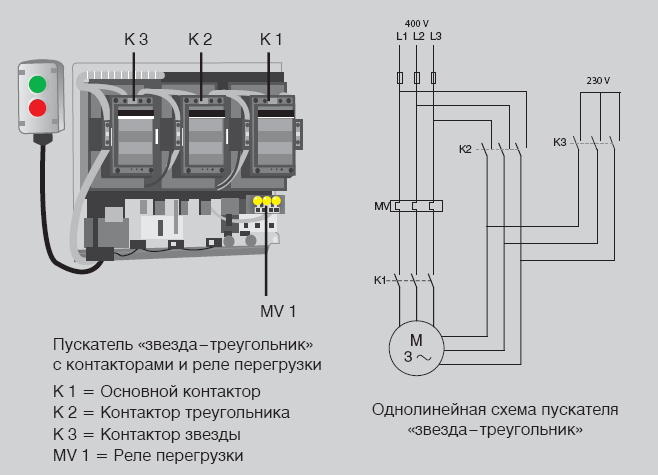
Control circuit.
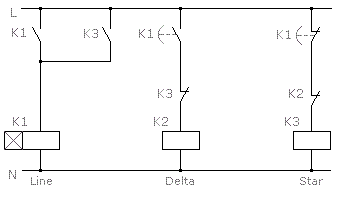
Connection of operational voltage, through time relay contact K1 and contact K2, in the coil circuit of contactor K3.
Turning on contactor K3 opens contact K3 in the coil circuit of contactor K2 (blocking erroneous activation), contact K3 closes in the coil circuit of contactor K1 combined with a pneumatic time relay.
Turning on contactor K1 closes contact K1 in the coil circuit of contactor K1 (self-feeding), at the same time the pneumatic time relay is turned on, which opens its contact K1 in the coil circuit of contactor K3 after a certain time, and also closes its contact K1 in the coil circuit of contactor K2.
Disabling contactor K3, contact K3 closes in the coil circuit of contactor K2.
Turning on contactor K2 opens contact K2 in the coil circuit of contactor K3 (blocking erroneous activation).
Power supply diagram.
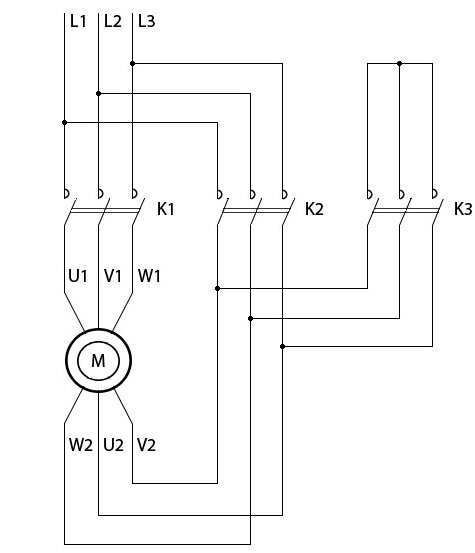
At the beginning of windings U1, V1 and W1 through power contacts magnetic starter K1 is supplied three phase voltage. When the magnetic starter K3 is triggered using its contacts K3, a short circuit occurs, connecting the ends of the windings U2, V2 and W2 to each other; the motor windings are connected by a star.
After some time, the time relay, combined with the starter K1, is activated, turning off the starter K3 and simultaneously turning on K2, the power contacts of K2 are closed and voltage is supplied to the ends of the motor windings U2, V2 and W2. Thus, the electric motor is switched on in a triangle pattern.
Warnings
1. Switching from star to delta is only permissible for engines with light starting mode, since when connected to a star, the starting torque is approximately half the torque that would be with direct starting. This means that this method of reducing the starting current is not always suitable, and if it is necessary to reduce the starting current and at the same time achieve a large starting torque, then they take an electric motor with a wound rotor, and a starting rheostat is introduced into the rotor circuit.
2. You can switch from star to delta only those electric motors that are designed to operate when connected in a delta, i.e., having windings designed for line voltage networks.
There is another common way to start asynchronous motors - switching from star to delta.
The star-delta switching method is used in motors that are designed to operate with delta windings connected. This method is carried out in three stages. At the beginning, the motor is started by connecting the windings in a star, at this stage the motor accelerates. Then they switch to the working triangle connection diagram, and when switching, you need to take into account a couple of nuances. Firstly, you need to correctly calculate the switching time, because if you close the contacts too early, the electric arc will not have time to go out, and it may also cause short circuit. If the switching takes too long, this can lead to a loss of motor speed, and as a result, an increase in current inrush. In general, you need to clearly adjust the switching time. At the third stage, when the stator winding is already delta-connected, the engine enters steady-state operating mode.
The meaning of this method is that when the stator windings are connected with a star, the phase voltage in them decreases by 1.73 times. The phase current that flows in the stator windings decreases by the same amount. When the stator windings are connected by a triangle, the phase voltage is equal to the linear voltage, and the phase current is 1.73 times less than the linear one. It turns out that by connecting the windings with a star, we reduce the linear current by 3 times.
To avoid getting confused by the numbers, let's look at an example.
Let's say that the working circuit of the winding of an asynchronous motor is a triangle, and the linear voltage of the supply network is 380 V. The resistance of the stator winding is Z = 20 Ohms. By connecting the windings at the moment of star starting, we will reduce the voltage and current in the phases.

The current in the phases is equal to the linear current and is equal to

After accelerating the engine, we switch from star to delta and get different values of voltages and currents. 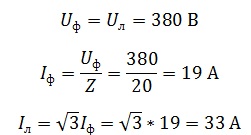
As you can see, the linear current when connected by a triangle is 3 times greater line current when connected by a star.
This method of starting an asynchronous motor is used in cases where there is a small load or when the engine is idling. This is due to the fact that when the phase voltage decreases by 1.73 times, according to the formula for the starting torque provided below, the torque decreases three times, and this is not enough to start with a load on the shaft.

Where m is the number of phases, U is the phase voltage of the stator winding, f is the frequency of the supply network current, r1,r2,x1,x2 are the parameters of the equivalent circuit asynchronous motor,p– number of pairs of poles.
The main methods of connecting three-phase electric motors are star or delta. These are special cases when three-phase loads connect via circuit breaker. In most cases, a universal motor connection is made - star-delta. At the same time, three phase electric motor Can also be connected to regular electrical wiring.
Connection methods: star and delta
Connecting the motor alternately in two ways, that is, star and triangle, is done by simply switching jumpers installed on the terminal block between the winding terminals.
The motor winding contacts are connected to the terminal box contacts. This electrical connection, in turn, is with the motor windings and power phases. Special jumpers are installed in the terminal box to allow switching from the “triangle” position to the “star” position. Power is supplied to the ends of the triangle, which are formed by the windings of the electric motor. When connecting in a star, the jumper is set in such a position that all three windings are connected at one point.
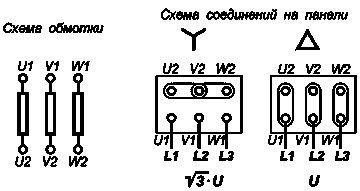
In a "triangle", on the contrary, each winding is connected to another, corresponding winding. Since the load in all windings is equal, there is no need for a neutral wire. IN modern conditions in a wiring diagram they are very often used to switch from star to delta mode. At the same time, the starting mode of the electric motor is significantly softened. However, the connection of the contactor itself does not change the general circuit at all, it’s just that an additional element appears between the electric motor and the machine. power device, which includes several contactors at once. 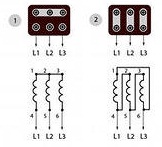
Switching from different positions
When the electric motor switches from the "triangle" position to the "star" position, its power decreases by almost three times. If the switch is performed in the opposite direction, then the engine power, on the contrary, increases very sharply. At the same time, it should be remembered that if the electric motor is not designed to operate in these conditions, it may simply burn out.
Motor connection - "star-delta" is used to reduce the starting current, the value of which is several times higher than the operating current of the motor. For high-power electric motors, the starting current is so high that its action can cause serious consequences and lead to a voltage drop. During the starting process, the rotation speed of the electric motor increases and the current decreases. After this, the windings switch to delta mode.